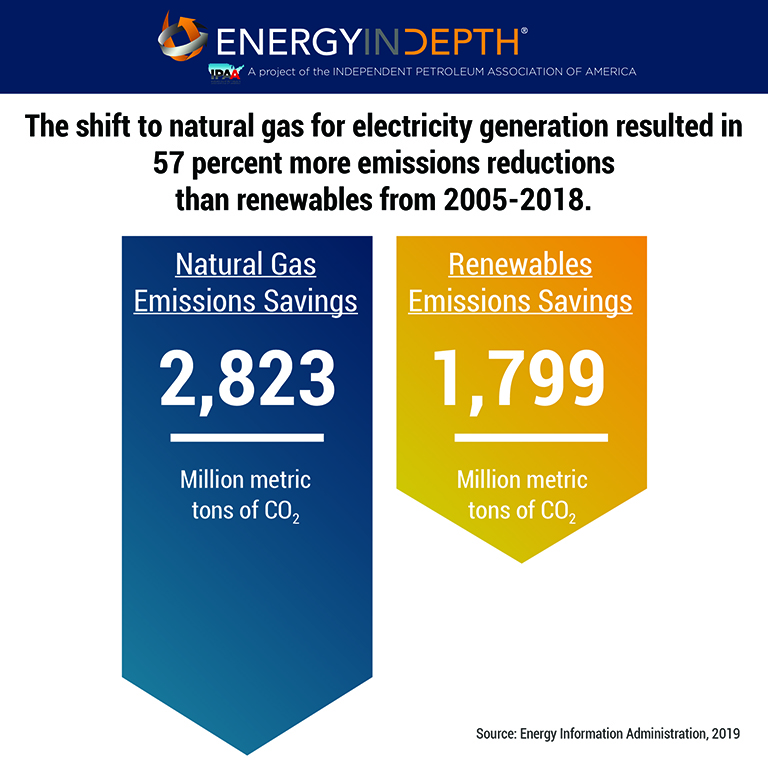UPDATE: U.S. Led World in CO2 Reductions For 10th Time This Century Last Year
UPDATE: Dec. 3, 2020
The U.S. Energy Information Administration (EIA) has projected U.S. energy-related carbon dioxide (CO2) emissions will decline 10 percent this year, putting the United States on pace to lead the world in annual CO2 reductions for the 11th time this century.
Though the unfortunate economic disruption brought on by the coronavirus pandemic is likely responsible for most of the reductions this year, the reductions achieved over the past 15 years have largely been attributable to fuel switching to natural gas in the power sector.
Not only has increased natural gas use been the primary reason the United States leads the world in CO2 reductions this century, a recent Bloomberg BNEF report notes that the U.S. is now on track to meet its Paris climate accord reduction pledges, as the following IPRB graphic illustrates.

Original Post: July 2, 2020
BP’s recently released Statistical Review of World Energy 2020 shows that in 2019 the United States led all nations in carbon dioxide (CO2) emissions reductions for the 10th time this century. U.S. CO2 emissions fell 152 million metric tons in 2019, three percent below 2018 levels, according to BP.
This continues a trend that has been observed more often than not since since the turn of the century. In fact, BP data show that the U.S. has reduced CO2 emissions a world-leading 755 million metric tons since 2000, outpacing the next four leading nations combined.
Experts agree that fuel-shifting to clean-burning natural gas from higher-emitting fuels in the power sector is the primary reason the U.S. has achieved these reductions over the past decade-plus. For example, the International Energy Agency (IEA) recently noted:
“The United States saw the largest decline in energy-related CO2 emissions in 2019 on a country basis – a fall of 140 Mt, or 2.9%, to 4.8 Gt. US emissions are now down almost 1 Gt from their peak in the year 2000, the largest absolute decline by any country over that period. A 15% reduction in the use of coal for power generation underpinned the decline in overall US emissions in 2019. Coal-fired power plants faced even stronger competition from natural gas-fired generation, with benchmark gas prices an average of 45% lower than 2018 levels. As a result, gas increased its share in electricity generation to a record high of 37%.”
U.S. Energy Information Administration (EIA) data show that from 2005 to 2018, a rapid shift to natural gas in the power sector reduced U.S. CO2 emissions 57 percent more than the emissions reductions realized through renewables, as the following Energy In Depth graphic shows.

However, despite the progress made by the United States and other nations that have achieved significant emissions reductions (four examples are listed in the graphic below) the BP report shows that overall global CO2 emissions increased 161 million metric tons in 2019.
This can be explained by another trend that has also been consistently observed in recent years. China’s CO2 emissions alone increased 319 million metric tons from 2018 to 2019, more than offsetting the United States’ declines.
So far this century, China’s emissions have increased by more than 6.4 billion metric tons, spiking at more than eight times the rate that U.S. emissions have declined over the same time-frame. Check out the following new IPRB infographic for perspective.
Considering China is already responsible for more than half of the world’s coal consumption and is ramping up coal consumption at the same time the U.S. and several other major countries are fuel-switching to clean-burning natural gas indicates these trends are unlikely to change any time soon. In fact, China has nearly as much new coal power generation in development as the United States had in operation last year, according to E&E News.
Due largely to the coronavirus pandemic – but also because of the continued trend of fuel-switching to natural gas and renewables – the EIA projects U.S. emissions will fall another 11 percent in 2020. The United States’ world-leading CO2 reductions can largely be attributed to innovation in the oil and natural gas industry.
But climate change is a global issue, which is why it is important to understand the big picture when it comes to greenhouse gas emissions. Based on simply math, it is clear that even the most onerous climate policies imposed in the United States and throughout the world will be not enough to offset rapidly increasing emissions from China.


[…] Illinois Petroleum Resources Board […]
[…] Illinois Petroleum Resources Board […]
[…] Illinois Petroleum Resources Board […]
[…] Illinois Petroleum Assets Board […]
[…] Illinois Petroleum Resources Board […]
[…] who has continually pushed climate hysteria. Rather, let’s talk more broadly. The United States continues to lead the world in emissions reduction. Meanwhile, Thunberg’s precious Europe is lagging well behind, with […]
[…] who has continually pushed climate hysteria. Rather, let’s talk more broadly. The United States continues to lead the world in emissions reduction. Meanwhile, Thunberg’s precious Europe is lagging well behind, with […]
[…] has continually pushed climate hysteria. Rather, let’s talk more broadly. The United States continues to lead the world in emissions reduction. Meanwhile, Thunberg’s precious Europe is lagging well behind, with […]
[…] who has continually pushed climate hysteria. Rather, let’s talk more broadly. The United States continues to lead the world in emissions reduction. Meanwhile, Thunberg’s precious Europe is lagging well behind, with […]
[…] who has continually pushed climate hysteria. Rather, let’s talk more broadly. The United States continues to lead the world in emissions reduction. Meanwhile, Thunberg’s precious Europe is lagging well behind, with […]
[…] has continually pushed climate hysteria. Rather, let’s talk more broadly. The United States continues to lead the world in emissions reduction. Meanwhile, Thunberg’s precious Europe is lagging well behind, with […]
[…] who has continually pushed climate hysteria. Rather, let’s talk more broadly. The United States continues to lead the world in emissions reduction. Meanwhile, Thunberg’s precious Europe is lagging well behind, with […]
[…] who has continually pushed climate hysteria. Rather, let’s talk more broadly. The United States continues to lead the world in emissions reduction. Meanwhile, Thunberg’s precious Europe is lagging well behind, with […]
[…] who has continually pushed climate hysteria. Rather, let’s talk more broadly. The United States continues to lead the world in emissions reduction. Meanwhile, Thunberg’s precious Europe is lagging well behind, with […]